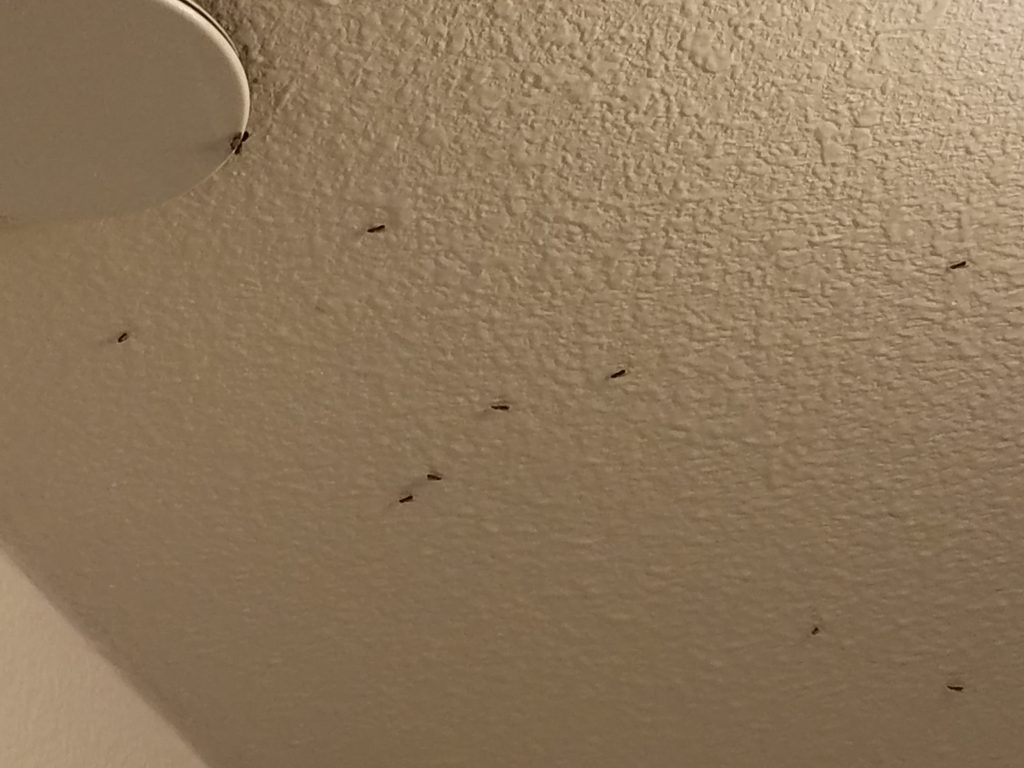Discovering tiny black bugs on your walls and ceiling can be a perplexing and frustrating experience. You might wonder where they came from, what they are, and, most importantly, how to get rid of them. In this article, we will explore the common types of tiny black bugs that infest homes, identify the potential causes of their presence, and discuss effective methods to eliminate and prevent them from returning.

Types of Tiny Black Bugs
To effectively deal with these tiny black intruders, it’s important to identify them. There are several common types of small black bugs that you might encounter:
- Black Carpet Beetles: Small oval-shaped insects actively infest carpets and other fabric materials. They can also be discovered on walls and ceilings, especially when actively hunting for food.
- Fungus Gnats: These tiny, black insects are often found near houseplants and in damp areas. They can be especially pesky if you have overwatered your plants.
- Booklice: Despite their name, booklice are not actual lice and do not bite humans. They are tiny, grayish-black insects that feed on mold and mildew and can be found on walls and ceilings, particularly in humid environments.
- Tiny Flies: Small black flies, such as fruit flies and drain flies, are common indoor pests that can be found on walls and ceilings, particularly around food sources and drains.
Read too: How Expensive Are Floor To Ceiling Windows
Identifying the Causes
To address the issue of tiny black bugs on your walls and ceiling, you need to understand the underlying causes:
- Food Sources: Many of these insects are attracted to food sources, whether it’s crumbs, spilled liquids, or decaying organic matter.
- Humidity and Moisture: High humidity or moisture in your home can create ideal conditions for certain insects, such as fungus gnats and booklice, to thrive.
- Plants: If you have indoor plants, the potting soil can provide a breeding ground for pests like fungus gnats.
- Leaky Pipes: Leaky pipes or drains can create a damp environment that attracts tiny flies like drain flies.
Effective Methods for Elimination
Once you’ve identified the type of tiny black bugs and the potential causes of their presence, it’s time to take action:
- Clean Thoroughly: The first step in eliminating these bugs is to clean your home meticulously. Pay special attention to areas where you’ve seen the bugs and remove any potential food sources.
- Inspect Plants: If you have houseplants, inspect the soil for signs of fungus gnats. Allow the soil to dry out between waterings to deter these pests.
- Fix Leaks: Address any plumbing leaks or drainage issues in your home to eliminate sources of excess moisture that may attract tiny flies.
- Use Traps: For flying insects like fruit flies and drain flies, use traps that can help capture and reduce their numbers.
- Insecticides: In severe infestations, you may need to use insecticides specifically designed for the type of bug you’re dealing with. Be sure to follow all safety instructions and consider seeking professional pest control services.
Preventing Future Infestations
To prevent the return of tiny black bugs on your walls and ceiling, consider the following measures:
- Maintain Cleanliness: Regularly clean your home to remove potential food sources and reduce the likelihood of infestations.
- Monitor Indoor Plants: Be mindful of your houseplants’ moisture levels and ensure proper drainage.
- Seal Entry Points: Inspect and seal any cracks or gaps that might allow pests to enter your home.
- Ventilation: Ensure good ventilation in areas prone to humidity and moisture to reduce favorable conditions for pests.
Conclusion
Tiny black bugs on your walls and ceiling can be a nuisance, but with proper identification and the right approach, you can eliminate and prevent their presence in your home. Understanding the type of bug and its preferred habitat is key to effective elimination. Keep your home clean, address humidity issues, and take preventive measures to ensure a bug-free living space.